Michael Brown
Children are suffering from violence in the U.S. and around the world.
Michael Brown. The children of Gaza. The refugees of Central America. Only three of numerous heart-breaking stories to fill the airwaves in the last month. But, unlike the gruesome murders of innocent news reporters by ISIL, these news stories about violence toward unarmed children have faced loud voices justifying that violence.
These voices argue for the “rule of law.” They insist on the inherent goodness of hyper-militarized, monocultural police forces using tanks and tear gas against peaceful protestors. They claim the inherent righteousness of the state of Israel, even after the bombing of United Nations schools. They defend border guards and those who clamber into busses to scream violence and hate at asylum-seeking children.
So, the wounded or dead are put on trial and convicted for their own deaths, even though they were unarmed children. It’s their fault. To say otherwise is just foolishness.
Some Corinthian Gentiles and Jews must have reacted in exactly this way to the teaching of Paul. Jesus was crucified by the Romans — the imperial power that had brought peace to the city of Rome and quiet to the provinces, that legendary pax Romana about Augustus Caesar himself boasted. This was Paul’s testimony.
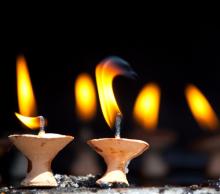
“What did you do on your summer vacation?”
Even now students may be answering that question in essays at the start of this new school year. Maybe you wrote such a paper years ago. No matter what you did or where you went this past summer, it was almost impossible to escape the heaviness of the headlines. #BringBackOurGirls has become a distant refrain, almost forgotten beneath the crush of summer tragedies:
Thousands of children traveled alone from Central American countries to enter the U.S. as refugees. Ebola deaths spread to more West African nations killing hundreds including many health workers. The forces of ISIS, intent on carving out an Islamic caliphate, took over major Iraqi cities and beheaded a U.S. journalist in Syria. Russia usurped Crimea and threatened the rest of Ukraine. The U.N. refugee agency announced in late August that “the number of refugees, asylum-seekers and internally displaced people worldwide has, for the first time in the post-World War II era, exceeded 50 million people.” Gaza has been reduced to rubble while Hamas rockets still fly toward Israeli cities. Michael Brown, an eighteen-year-old African American man who might have started college this week, was shot and killed by a white police officer in the waning days of August.
After such a summer, how can we do anything but scoff at Paul’s words from Romans?
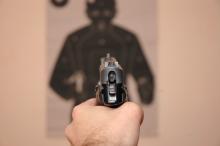
In Ferguson, an unarmed black teenager was killed by police. In reaction, thousands took to the streets in protest. However, rather than attempting to listen, the heavily militarized police immediately made a show of force with armored vehicles, assault rifles, riot gear, and tear gas. People tweeted photos and videos more reminiscent of scenes from Baghdad or Fallujah than of a little Midwestern suburb in America.
Tear gas and rubber bullets were fired into the crowd of peaceful protestors. Multiple reporters were assaulted and arrested. One cop was caught on video screaming “Bring it, all you f---ing animals! Bring it!” Another appeared to be indiscriminately pointing his rifle in people’s faces and yelling “I will f---ing kill you!”
This raises the question: Is what we saw night after night in Ferguson simply a matter of a few “bad apple” cops, a local isolated problem? Or is it indicative of a wider attitude of the police in relation to the use of violence and force? Is it an anomaly, or is this what police in fact consider normal and right? In an op-ed piece in the Washington Post, a 17-year veteran of the LAPD gives us what he believes to be good advice from the perspective of a cop:
“If you don’t want to get shot, tased, pepper-sprayed, struck with a baton or thrown to the ground, just do what I tell you. Don’t argue with me ... and don’t even think of aggressively walking towards me. ”
In one sense he is of course right. If a guy has a gun at your head you should definitely not argue, and just do what he says. But one is led to ask how this reasoning is substantially different from saying to a child, “Honey, when dad is drunk and gets mad, don’t talk back, just be real quiet.” That’s probably sound advice, too, but it begs the question: Is this the world we want to live in? Is that as good as we can do?

It’s been said that our politics are often shaped by what we see out the window.
Twenty years ago, if you would've asked me if I thought police treat people fairly regardless of race, I would have confidently said, “Yes” — just like 70 percent of white folks in the recent Pew survey. In fact, 30 years ago, if you would've asked me what I wanted to be when I grew up I’d have said “a policeman.”
I grew up in a small town in Tennessee, which was still very segregated. Growing up, we knew the police officers by name. On more than one occasion, the police saved the day, and countless news stories celebrated the heroism and courage of police officers.
My mom and I used to go on walks together in a park, and I always looked forward to bumping into the officer who patrolled the park. She was tough as nails but always greeted me with an enthusiastic smile and a big bear hug. At the age of ten, she appointed me a “Junior Officer,” and she gave me a “real metal badge.” I felt like I was at the top of the world, and on my way to be officer of the year.
And then my window changed.
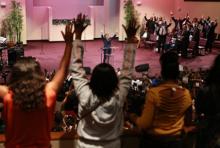
ST. LOUIS — Justice was a recurring theme as thousands of mourners packed the mammoth Friendly Temple Missionary Baptist Church on Monday for the funeral of Michael Brown, a black teen whose fatal shooting following a confrontation with a white police officer set off weeks of sometimes violent protests.
The Rev. Al Sharpton, among the speakers, called for a “fair and impartial investigation” into the shooting.
“We are not anti-police, we respect police,” Sharpton said. “But those police that are wrong need to be dealt with just like those in our community who are wrong need to be dealt with.”
Benjamin Crump, a lawyer representing Brown’s family, alluded to the “three-fifths” clause in the Constitution for counting slaves (which actually was an anti-slavery clause) and demanded that Brown get “full justice, not three-fifths justice.”
Brown’s body was being laid to rest, but the controversy surrounding the Aug. 9 shooting was far from over. Prosecutors have not determined whether the Ferguson police officer, 28-year-old Darren Wilson, will face charges in Brown’s death.

Like many of you, I’ve been overwhelmed and deeply saddened by the events that have transpired in Ferguson, Mo. And at times I’ve felt helpless, 350 miles away in Cincinnati, as friends of mine are in Ferguson praying, marching, organizing, and working for peace and justice.
In my conversations with friends of color, I have witnessed their pain and frustration and deep angst over the events of Ferguson. The past two weeks have hit very close to home for them.
With white friends, the response has been mixed, but the overwhelming sentiment is one I’ve already identified: helplessness. I am not satisfied with this response. I believe there are ways we can respond, bear witness, be in solidarity and work for justice in this moment. Our love for God and neighbor demands we engage. If you are like me, you are praying without ceasing for the Shalom, peace, and justice of God to reign in the hearts and minds and streets of Ferguson and throughout this nation and world. So how can we pair our prayers with constructive action?
Here are ten ways white Christians can respond to Ferguson.
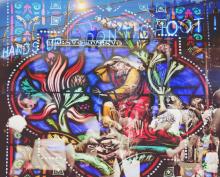
"Then the LORD said, 'I have observed the misery of my people…I have heard their cry…Indeed, I know their sufferings…’ - Exodus 3:7
For the last few weeks, the eyes of America have been riveted on the town of Ferguson, Missouri, a formerly little-known suburb of St. Louis. It was there on Aug. 9 that an unarmed African-American teenager named Mike Brown was shot six times by police, sparking ongoing protests and demonstrations by grief-stricken and outraged citizens. Clashes between demonstrators and heavily armed local police, highway patrol, and the Missouri National Guard have been the subject of extensive coverage and all manner of commentary across broadcast and social media.
These demonstrations in Ferguson represent something more than just lament for the tragic death of Mike Brown. They are an outcry at the demonization of black men, racial profiling, institutional racism, intergenerational poverty, the militarization of law enforcement, and a culture of incarceration in America. Over the last three weeks, Ferguson has become a flash point for urgent issues facing minority communities, issues which have been largely unnoticed or ignored by the majority white culture. The #Ferguson hashtag no longer just refers to the events happening in Ferguson but has come to represent a national conversation about the toll that institutional racism and its many diabolical expressions have taken on our fellow Americans.
In the days following Mike Brown’s death, columnist Leonard Pitts, Jr. described the protests as “an act of outcry, a scream of inchoate rage. That’s what happened this week in Ferguson, Mo. The people screamed.” These screams echo of the cries that God heard from the Hebrews enslaved in ancient Egypt.

As the Rev. Barbara Williams-Skinner collected signatures for a statement by leaders of African-American church groups about the Ferguson, Mo., police shooting of Michael Brown, she found more people wanted to join in.
The general secretary of the National Council of Churches wanted to add his name; an Asian-American evangelical leader, too.
What started out as a “Joint Statement of Heads of Historic African American Church Denominations” has become an interracial cry for justice.
“It’s touching hearts of people who have sons and who know that their sons would not be treated this way,” said Williams-Skinner, co-chair of the National African-American Clergy Network, on Thursday. “They know it’s wrong. They know it’s wrong before God. And they are responding on a human level.”
Last night, Washington, D.C., residents young and old gathered in the Columbia Heights neighborhood to protest the shooting of Michael Brown, stand in solidarity with those on the front lines of continued protests in Ferguson, Mo., and let our governmant and law enforcement officials know that #BlackLivesMatter. The protest was organized by a Howard University student who hails from St. Louis and "needed to do something" given the reports she received from friends and family on the ground in Ferguson.
About a dozen Sojourners employees were in attendance. Check out the video below with testimony from two protestors who spent some time over the last week in Ferguson.

I’ve been calling it the Summer of Helplessness.
From the conflict in Gaza that has left more than 1,000 civilians dead, to the downing of Malaysia Airlines Flight 17 over the skies of Ukraine, to the Ebola breakout getting worse by the day, to the shooting of yet another unarmed black teenager here in the U.S., the news of late is enough to make a person feel paralyzed with helplessness and despair. My prayers these days are of the tired, desperate sort: How long, O Lord? Will you hide your face from us forever?
But when it comes to violence and oppression, we are rarely as helpless as we think, and this is especially true as the events unfolding in Ferguson force Americans to take a long, hard look at the ongoing, systemic racism that inspired so many citizens to protest in cities across the country this week.
I’ve heard from many of my white friends and readers who say they aren’t sure how to respond to the anger and grief they are watching on TV or hearing from their black friends. They want to be part of the solution but don’t know where start. They may even feel a little defensive when they hear people talking about white privilege or inaction on the part of white Christian leaders. I’m in the process of learning too, but as I’ve listened to people of color whose opinions I trust, I’ve heard them issue several calls to action we can all heed.

As America began to gear up for its incredibly wasteful (more than $40 trillion since 1972) and utterly futile “War on Drugs,” there were three critical federal actions that contributed to our current vastly over-militarized police forces.
In 1981, the Military Cooperation with Law Enforcement Act was passed. This law authorized military collaboration with civilian law enforcement agencies and dramatically expanded the Army’s participation in counterdrug efforts and included arming and training of local police with military grade weapons, free of charge, at the discretion of the Secretary of Defense.
Then, in 1984, Congress passed the Comprehensive Crime Control Act, supposedly to assist in controlling the crack cocaine infusion in urban communities. This law, tied to a civil forfeiture provision, allows law enforcement to seize property without a conviction, or even charges being levied, if a person is suspected of illegal drug activity.
Finally, in the 1990 National Defense Authorization Act (each year this bill funds our military) there was included a provision — “Section 1208” — that allowed the Secretary of Defense to transfer weapons and ammunition that was “suitable for use by such agencies in counter-drug activities.” This law was supposed to give police the firepower needed to “effectively” execute the Drug War. In the 10 years that followed, thousands of tanks, helicopters, grenade launchers, and assault rifles were granted to municipal police forces.
But the militarization of our police forces was not yet complete.
Enter the “War on Terror.”
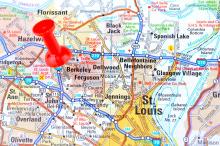
I am white. Most of the people near my house are white. This is the way it is for most of us white people in the U.S., and as we continue to be shown, the consequences are both critical and countless.
While the Fair Housing Act of 1968 prohibits all forms of housing discrimination, the U.S. Department of Housing and Urban Development estimates that millions of instances occur each year, thus residential segregation continues to be a common facet of modern day life. To put it simply, white people tend to live by other white people, and it is the way it is by no accident.
Segregated neighborhoods are often reinforced by the practice of racial “steering” by real estate agents, or when landlords deceive potential tenants about the availability of housing or perhaps require conditions that are not required of white applicants. In addition, lending institutions have been shown to treat mortgage applicants differently when buying homes in non-white neighborhoods in comparison to their attempt to purchase in white neighborhoods. As a result of such practices, white people tend to live in a state of residential separateness, for as the most recent U.S. Census date confirms, genuine racial integration is — for the most part — alarmingly rare.
Of course, our own behaviors contribute to our current state of affairs. White people seem to prefer housing located by other white people. As a result, far too many white people are willing (and able) to pay a premium to live in predominantly white neighborhoods. So equivalent housing in white areas commands a higher rent than others, and through the process of bidding-up the costs of housing, many white neighborhoods effectively shut out people of color, because those without white skin are more often unwilling (or unable) to pay the premium price to buy entry into such white neighborhoods. As a result of such white flight and isolation, not only do we witness a rise in racial ignorance and indifference, but it also leads to increased injustice in the form of disproportionate hostility directed at people of color.
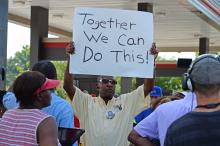
It was July 19, 2013, and we were leaving New York City for a spiritual retreat, six days after a Florida jury found George Zimmerman “not guilty” in the death of Trayvon Martin. The sadness, anger, and weariness was well worn on the liturgies, prayers, and preaching of many of the churches in our Harlem neighborhood.
We found ourselves joining local church leaders and a few pastors in a conversation about justice that would eventually make its way toward a broad range of matters: the gay rights of questioning teens, clean water for children in Africa, and many of the frequent places conversations go with folks who are concerned with “loving our neighbor.” And so we sat, we listened, and were genuinely moved to openly share about the challenges and opportunities that have come with cultivating safe spaces for GBLT folks in our church community. TOGETHER we also inspired one another as we offered our collective experiences with integrating the arts in fundraising for international relief efforts.
And as Jose and I sat, listened, and shared TOGETHER, we found ourselves with heavy hearts waiting …“Would the conversation broach the tragedy of Trayvon Martin?” It didn’t.
And as we sat TOGETHER in sacred solidarity with compassionate, justice-minded pastors, who happened to be white, somehow we found ourselves feeling quite alone. So we mustered the courage to ask, “How have your churches responded to the Trayvon Martin verdict?” My question was met with silence. The silence that met us did not betray aloof or timid spirits, but rather uncertainty about whether their one voice could really make a difference, or that somehow they did not have the right to “speak on behalf” of brown and black realities.

Christians often talk about actively changing the world, but too often, we just sit still and passively watch the struggles of others without participating, leading, or caring. We don’t love.
Why? Because many Christians have an inability to use their imaginations.
People who can’t imagine are susceptible to bigotry, racism, hatred, and violence toward others. Why? Because they can’t imagine any other scenario, perspective, or opinion other than their own. They have an inability to see themselves in someone else’s shoes. They can’t see beyond their own narrow reality.
When you can’t imagine, you can’t empathize, understand, or relate with the actions, struggles, pain, suffering, persecution, and trials of others — you become apathetic, unmoved, stoic, and inactive.
Whether our differences are gender-related, age-related, race-related, culturally related, politically related, economically related, socially related, theologically related, value-related, or related to any countless number of factors, overcoming them requires imagination.
When you can’t imagine, you can’t celebrate, appreciate, admire, and joyfully love others. You disconnect yourself from humanity.
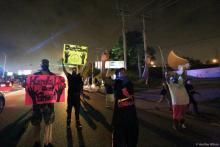
I have so much emotions and thoughts in my mind, heart, and body – in light of the oh-so-much that is going on all around the world – including the utterly tragic, brutal, and unnecessary “death” of Michael Brown.
But I thought it would be helpful to share a few thoughts how churches, Christians, and leaders can be engaging the events of the past 11 days in their respective churches – now and in the future. I’m not suggesting that pastors have to completely alter their sermons or Bible studies, but to altogether ignore the injustice of Michael Brown’s death would be altogether foolish.
To be blunt and I say this respectfully,
The integrity of the church is at stake because when it’s all said and done, it’s not a race issue for me — it’s a Gospel issue. It’s a Kingdom issue. We shouldn’t even let isolated issues in themselves hijack the purpose of the church. The Gospel of Christ is so extraordinary that it begins to inform (and we pray, transform) all aspects of our lives. So, in other words, we talk about race and racism because we believe in the Gospel.
So, here are five suggestions for Christians, leaders, and churches.
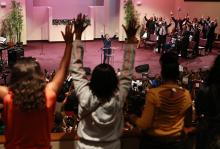
Civil rights leader the Rev. Al Sharpton told a packed church on August 17 that the Michael Brown case would mark a defining moment in civil rights history and fundamentally change the way police engage with the African-American community.
“Michael Brown is going to change this town,” Sharpton said to a massive, boisterous crowd that clapped and shouted in response.
Hundreds filled the pews of Greater Grace Church. More crowded into the foyer, and hundreds remained on the parking lot unable to enter, all in a show of support for the African-American teenager who was shot by a police officer on August 9.
Sharpton announced a future march in Washington on policing. He criticized the militarization of police, saying they act as if they are “at war with…citizens.” Sharpton urged the crowd to start showing up at the polls to vote and make a difference in the lives of African-Americans.
“Nobody can go to the White House unless they stop by our house,” Sharpton said. “We’ll be here until justice is achieved.”
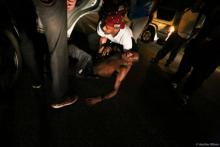
Editor's Note: Rev. Alvin Herring is on the ground in Ferguson, Mo. Following is his account of the events of Aug. 17.
Last night democracy was trampled not as the media would suggest by the angry footfalls of sullen youth determined to disturb the peace and wreak havoc in their own community, but by the heavy march of a police force that seemed determined to create tension and antagonize young people — young people who are carrying the trauma of nights of unrest and lifetimes of dehumanizing racism.
We witnessed with our own eyes beautiful young people peacefully marching in step to cries of “hands up, don’t shoot.” We saw the very young holding older siblings’ hands and the old being pushed in wheelchairs by teenagers who had pain in their eyes but strong voices lifting up their laments to a nation that must find the will to hear them. And though they were clearly agitated, they were courageously hewing to the commitment to act peacefully in the face of an overwhelming police response that seemed determined to escalate an already tense situation.
Law enforcement was outfitted with the machinery of war. The officers wore military fatigues and carried automatic weapons. They were helmeted, with their faces obscured, and in the darkness they looked more like machines than human beings. They perched atop huge military vehicles with glaring lights and screeching sirens. It was otherworldly — and all of this to face down a group of wounded children, wounded tonight and many nights before this night.

Our nation has a problem. It is not a “black” problem or a “white” problem, but a “human” problem that we all succumb to — and have the power to change. Our beloved nation was NOT “conceived in liberty” OR “dedicated to the proposition that all men are created equal,” despite President Lincoln’s well-intentioned words. That was the hope, but it has never been the reality.
Many of my African-American sisters and brothers are furious. Yet another child has been felled. The challenge is this — if a tree falls in the forest and white folks don’t hear it, does it make a noise? Many of us who are white do not have the contextual experience or the “ears to hear” to understand the fear and the fury.
More than a decade ago, I pastored in a community that was predominately African American. It grew from 72 percent to 98 percent black in just seven years as a result of “white flight.” In the course of this time, the police force struggled because it didn’t listen to the people. Most of the officers were white and could legally live up to 30 miles away; as a result many (including the chief) lived in another state.
At one heated meeting, the police chief informed us what we “could” and “could not” do as we discussed community initiatives that included the older white and adolescent black residents in conversation and collaboration. Finally, as the pastor of one of the larger churches in town, I stood up and said, “Chief, please understand that we are not asking for your permission. We are telling you what we, as citizens of this town, are going to do. Now we need to know — are you with us? Or not?” The African-American residents stood and clapped loudly. I felt their pain and the reason for what some perceived as “paranoia,” but what I knew to be legitimate fury.

A soon-to-be college-bound Michael Brown is shot by Missouri police, reportedly while holding his hands above himself in surrender and while unarmed. The resulting protests turn violent, leading ultimately to police setting up barricades, complete with snipers, tear gas, and flash grenades. Local stores are decimated and scores are injured in the resulting tensions.
Not long ago, Eric Garner, another African-American man, died of suffocation while being submitted to a choke submission hold by a New York policeman.
Last year in North Carolina, a black man was shot 10 times by a policeman. And all of this is in the shadow the Trayvon Martin, whose tragic and unnecessary death, is still fresh in our minds and hearts.
As cited on the Economist website , it’s enough to elicit a grim question from Delores Jones-Brown, director of the John Jay College on Race, Crime and Justice. “People are asking,” she says, “Is it open season on us?”
Meanwhile, half a world away in Iraq, ISIS continues to wreak havoc, and the United States has resumed an airstrike campaign after a decade of military force trying to maintain a tentative peace in a fractured nation. Hardly a day goes by when we don’t have reports of more Israeli and Palestinian blood spilled over the historic Gaza conflict, and Russian President Vladimir Putin continues to — in the words of a recent TIME Magazine article — “create problems only he can solve.” All the while, he stokes resentments between east and west not seen since the Cold War, seeking, too, to weaken the cohesive strength of NATO and to drive a wedge between the United States and its allies in Europe.
What’s happening to us?
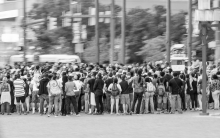
Editor's Note: In light of this week’s events in Ferguson, Missouri, several writers at ON Scripture took a few moments to reflect upon what they would/will be preaching on this Sunday. To continue the conversation, join on Twitter at #onscripture.
Eric D. Barreto, Associate Professor of New Testament, Luther Seminary: St Paul, MN
The last thing a preacher wants to do on a Saturday night is to log into Facebook.
I exaggerate, of course, but I found myself scrambling last week when I learned of Michael Brown’s shooting last Saturday. My sermon for Sunday morning was ready to go. But I had to reassess all my work when I heard the witness of so many African American friends in particular as the news from Ferguson began spreading across social media. The frustration and disbelief, rage and disappointment, resignation and passion I heard moved me. But even more convicting was the fact that so many others were simply unaware of this event at the moment and unfazed by its repercussions.
In certain communities, no one had to pay attention to Michael Brown. In certain communities, his death did not resonate with significance. In certain communities, no one would confront the preacher and ask why she did not respond to the death of this young person.
And yet in other communities, his death was a touchstone, a cause for prayer and lament and righteous anger and faithful expectation.
These distinct reactions are a raw reminder that our communities of faith remain largely segregated. Though we worship the same God, the contexts within which we seek God’s face are radically different. In such a divided context, what does it look like to love your neighbor? What does it look like to be “one” church even as we are profoundly divided?